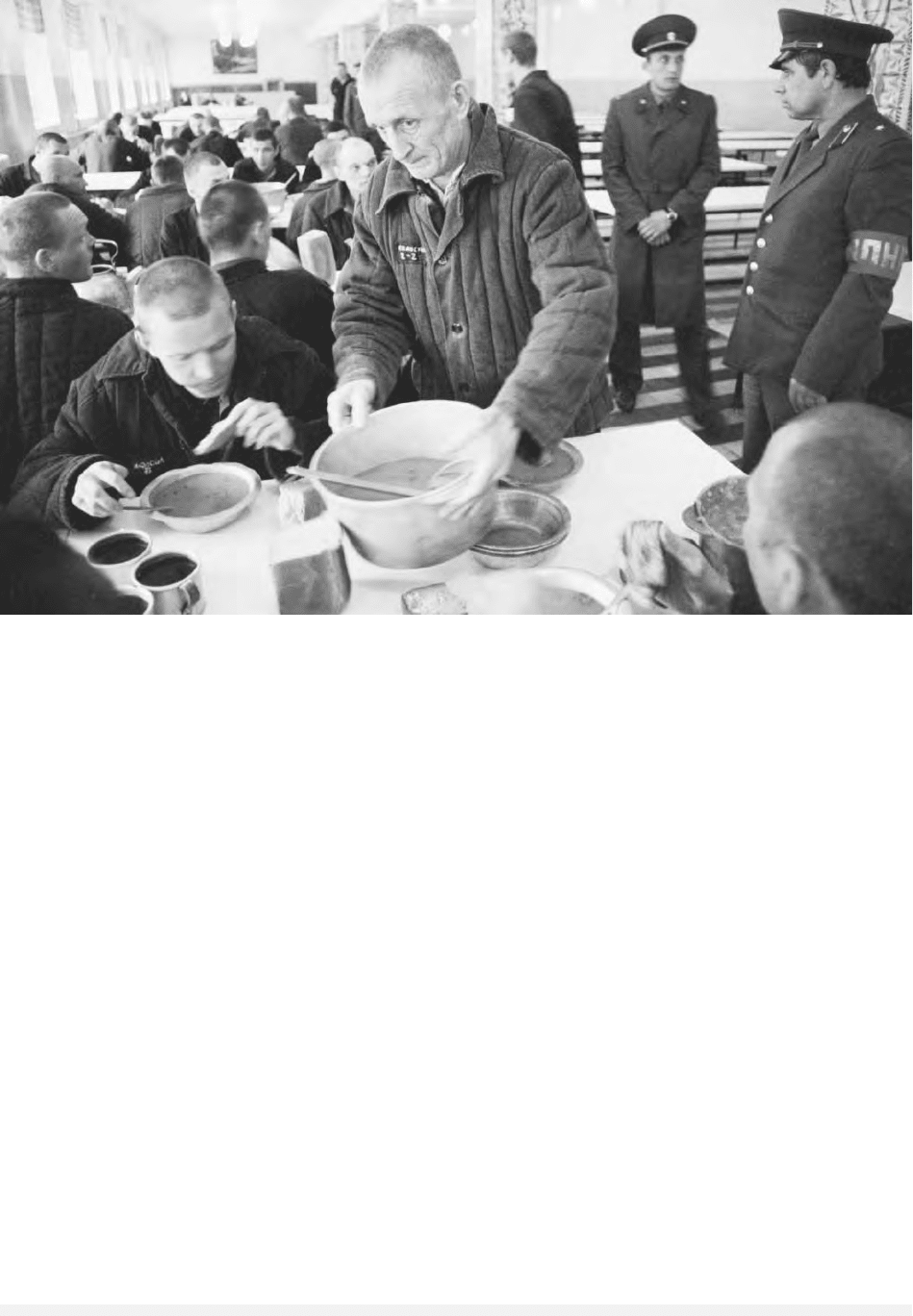Encyclopedia of Russian History
Подождите немного. Документ загружается.


PRIMAKOV, YEVGENY MAXIMOVICH
(b. 1929), orientalist, intelligence chief, foreign
minister, and prime minister under Boris Yeltsin.
Born in Kiev, Yevgeny Maximovich Primakov
grew up in Tbilisi; his father disappeared in the
purges. Trained as an Arabist, Primakov worked in
broadcasting in the 1950s and then became a Mid-
dle East correspondent for Pravda (and perhaps a
covert foreign intelligence operative). In the 1970s
he assumed academic posts as deputy director of
the Institute of World Economics and International
Relations (IMEMO), then as director of the Institute
of Oriental Studies, and in 1985 as director of
IMEMO.
In 1986 Primakov became a candidate member
of the Central Committee of the Communist Party
of the Soviet Union, and a foreign policy advisor
to Mikhail Gorbachev. He was chosen in June 1989
to chair the Congress of People’s Deputies, the lower
house of the Supreme Soviet formed pursuant to
Gorbachev’s new constitution. His party status
rose accordingly: full Central Committee member
in April 1989 and candidate member of the Polit-
buro in September. He was a leading contributor
to the “New Thinking” regarding international co-
operation that was identified with Gorbachev.
Primakov condemned the attempted coup by
hard-line communists in August 1991; Gorbachev
then made him First Deputy Chairman of the KGB
and head of foreign intelligence. He was one of the
few Gorbachev appointees to be retained in office
by Russian President Boris Yeltsin after the Soviet
Union was dissolved in December 1991.
Appointed foreign minister in January 1996,
Primakov was a realistic and cool professional. He
was a strong defender of Russian national interests,
as opposed to the pro-Western stance of his prede-
cessor Andrei Kozyrev, and often manifested pro-
Arab sympathies. Espousing a “multipolar” world,
he nonetheless avoided direct confrontation with
the West and bargained for a Russian presence at
NATO as it was expanding eastward. Later he crit-
icized the 1999 NATO bombing campaign against
Yugoslavia but kept open a Russian role in the
Kosovo settlement.
Following the August 1998 economic and po-
litical crisis, Primakov emerged as a compromise
candidate for prime minister. Overwhelmingly con-
firmed by the Duma in September, he was the most
popular politician in Russia. His model for eco-
nomic stabilization was President Franklin Roo-
sevelt’s New Deal in the United States.
As prime minister, Primakov soon aroused the
jealousy of the ailing Yeltsin and alarmed the pres-
ident’s family and cronies by investigating corrup-
tion. Yeltsin emerged from a long period of torpor
and dismissed Primakov in May 1999 in favor
of Interior Minister Sergei Stepashin. In reply, Pri-
makov accepted the leadership of the “Fatherland-
All Russia” bloc to oppose Yeltsin’s forces in the
Duma elections of December 1999, and was a
strong contender for the presidency in the elections
due the following year. But in August Yeltsin re-
placed Prime Minister Stepashin with Vladimir
Putin, who set up his own party, Unity, and cap-
italized on the war in Chechnya to forge ahead of
Primakov’s people. Primakov withdrew as a pres-
idential contender in order to run for speaker of the
new Duma; however, Putin made a deal with the
communists to keep Gennady Seleznyov as speaker
PRIMAKOV, YEVGENY MAXIMOVICH
1223
ENCYCLOPEDIA OF RUSSIAN HISTORY
Russian statesman Yevgeny Primakov served Boris Yeltsin as
foreign minister, prime minister, and spy master. P
HOTOGRAPH BY
A
LEXANDER
Z
EMLIANICHENKO
. AP/WIDE WORLD PHOTOS. R
EPRODUCED
BY PERMISSION
.

and marginalize Primakov. Those maneuvers not-
withstanding, in the March 2000 election Primakov
endorsed Putin, who subsequently tapped him for
occasional diplomatic missions. In 2001 Primakov
retired from the presidency of Fatherland-All Rus-
sia as it was preparing to merge with Unity.
See also: FATHERLAND-ALL RUSSIA; GORBACHEV, MIKHAIL
SERGEYEVICH; YELTSIN, BORIS NIKOLAYEVICH
BIBLIOGRAPHY
Daniels, Robert V. (1999). “Evgenii Primakov: Contender
by Chance.” Problems of Post-Communism 46(5):
27–36.
Shevtsova, Lilia F. (1999). Yeltsin’s Russia: Myths and Re-
ality. Washington, DC: Carnegie Endowment for In-
ternational Peace.
Simes, Dmitri K. (1999). After the Collapse: Russia Seeks
Its Place as a Great Power. New York: Simon & Schus-
ter.
R
OBERT
V. D
ANIELS
PRIMARY CHRONICLE
The compilation of chronicle entries known as the
Povst’ vremennykh lt (PVL) is a fundamental source
for the historical study of the vast eastern Euro-
pean and Eurasian lands that include major parts
of Ukraine and Belarus, as well as extensive parts
of the Russian Federation and Poland. As the sin-
gle most important source for the study of the early
Rus principalities, it contains the bulk of existing
written information about the area inhabited by
the East Slavs from the ninth to the twelfth cen-
tury, and has been the subject of many historical,
literary, and linguistic analyses. The PVL in vari-
ous versions appears at the beginning of most
extant chronicles compiled from the fourteenth
through seventeenth centuries
The PVL may have been compiled initially by
Silvestr, the hegumen of St. Michael’s Monastery
in Vydobichi, a village near Kiev, in 1116. The at-
tribution to Silvestr is based on a colophon in copies
of the so-called Laurentian branch where he de-
clares, “I wrote down this chronicle,” and asks to
be remembered in his readers’ prayers (286,1–286,7).
It is possible that Silvestr merely copied or edited
an already existing complete work by the Kiev
Caves Monastery monk mentioned in the heading
(i.e., “The Tale of Bygone Years of a monk of the
Feodosy Pechersky Monastery [regarding] from
where the Rus lands comes and who first in it be-
gan to rule and from where the Rus land became
to be”), but it is also possible that this monk merely
began the work that Silvestr finished. An interpo-
lation in the title of the sixteenth-century Khleb-
nikov copy has led to a popular notion that Nestor
was the name of this monk and that he had com-
pleted a now-lost first redaction of the complete
text. But that interpolation is not reliable evidence,
since it may have been the result of a guess by the
interpolator, in which case the name of the monk
referred to in the title or when he compiled his text
is not known. So the simplest explanation is that
Silvestr used an earlier (perhaps unfinished) chron-
icle by an unknown monk of the Caves Monastery
along with other sources to compile what is now
known as the PVL. Silvestr’s holograph does not
exist; the earliest copy dates to more than 260 years
later. Therefore, researches have to try to recon-
struct what Silvestr wrote on the basis of extant
copies that are hundreds of years distant from its
presumed date of composition.
There are five main witnesses to the original
version of the PVL. The term “main witness,” refers
only to those copies that have independent au-
thority to testify about what was in the archetype.
Since most copies of the PVL (e.g., those found in
the Nikon Chronicle, Voskresenskii Chronicle, etc.)
are secondary (i.e., derivative) from the main wit-
nesses, they provide no primary readings in rela-
tion to the archetype. The five main witnesses are:
1. Laurentian (RNB, F.IV.2), dated to 1377;
2. Radziwill (BAN, 34. 5. 30), datable to the 1490s;
3. Academy (RGB, MDA 5/182), dated to the 15th
century;
4. Hypatian (BAN, 16. 4. 4), dated to c. 1425;
5. Khlebnikov (RNB, F.IV.230), dated to 16th cen-
tury.
In addition, in a few places, the Pogodin Chronicle
fills in lacunae in the Khlebnikov copy:
6. Pogodin (RNB, Pogodin 1401), dated to early
17th century.
One can also draw textual evidence from the
corresponding passages in the later version of the
Novgorod I Chronicle. To date, there are no litho-
graphs or photographic facsimilies of any manu-
script of the Novgorod I Chronicle. The three copies
of the published version of Novg. I are:
1. Commission (SPb IRI, Arkh. kom. 240), dated
to 1450s;
2. Academy (BAN 17.8.36), dated to 1450s;
PRIMARY CHRONICLE
1224
ENCYCLOPEDIA OF RUSSIAN HISTORY

3. Tolstoi (RNB, Tolstovoi F.IV.223), dated to
1820s.
One can also utilize certain textual readings
from the corresponding passages of Priselkov’s re-
construction of the non-extant Trinity Chronicle.
The stemma, or family tree, shows the ge-
nealogical relationship of the manuscript copies.
Although various theories have been proposed
for the stages of compilation of the PVL, little agree-
ment has been reached. The sources that the com-
piler(s) utilized, however, are generally recognized.
The main source to 842 is the Chronicle of Georgius
Hamartolu and to 948 the Continuation of Symeon
the Logothete. Accounts of the ecumenical councils
could have been drawn from at least three possible
sources: (1) a Bulgarian collection, which served as
the basis for the Izbornik of 1073; (2) the Chronicle
of Hamartolus; and (3) the Letter of Patriarch Photius
to Boris, Prince of Bulgaria. Copies of treaties between
Byzantium and Rus appear under entries for 907,
912, 945, and 971. The Creed of Michael Syncellus
was the source of the Cree d taught to Volodimir
I in 988. Metropolitan Hilarion’s Sermon on Law and
Grace is drawn upon for Biblical quotations re-
garding the conversion of Volodimir I. There are
also excerpts from the Memoir and Eulogy of
Volodimir that are attributed to the monk James.
The Life of Boris and Gleb appears in the PVL but in
a redaction different from the independent work
written by Nestor. Quotations in the PVL attrib-
uted to John Chrysostom seem to be drawn from
the Zlatoustruiu (anthology of his writings). Sub-
sequently two references are made in the PVL to
the Revelations of Pseudo-Methodius of Patara. Var-
ious parts of the PVL draw on the Paleia (a synop-
sis of Old Testament history with interpretations).
PRIMARY CHRONICLE
1225
ENCYCLOPEDIA OF RUSSIAN HISTORY
Figure 1.
Radziwill
Academy
(Moscow)
[Trinity]
Laurentian
Khlebnikov
Pogodin
Ermolaev
Hypatian
Tolstoi
Synod
Commission
Academy
(St. Petersburg)
ß
α
γ
δ
ε
ζ
η
θ
ι
SOURCE: Adapted from Palaeoslavica. 7:18, 1999.

In the entries for 1097 to 1100, there is a narra-
tive of a certain Vasily who claims to have been an
eyewitness and participant in the events being de-
scribed. Volodimir Monomakh’s Testament and Let-
ter to Oleg appear toward the end of the text of the
chronicle. Finally, oral traditions and legends seem
to be the basis for a number of other accounts, in-
cluding the coming of the Rus’.
Although the text of the PVL has been published
a number of times including as part of the publica-
tion of later chronicles, only recently has a critical
edition based on a stemma codicum been completed.
See also: BOOK OF DEGREES; CHRONICLES; KIEVAN RUS;
RURIKID DYNASTY
BIBLIOGRAPHY
Cross, Samuel H., and Sherbowitz-Wetzor, Olgerd P.
(1953). The Russian Primary Chronicle: Laurentian
Text. Cambridge, MA: Mediaeval Academy of Sci-
ences.
Ostrowski, Donald. (2003). The Povest’ vremennykh let: An
Interlinear Collation and Paradosis, 3 vols., assoc. ed.
David J. Birnbaum (Harvard Library of Early Ukrain-
ian Literature, vol. 10, parts 1–3). Cambridge, MA:
Harvard University Press.
D
ONALD
O
STROWSKI
PRIMARY PARTY ORGANIZATION
Primary Party Organization (PPO) was the official
name for the lowest-level organization in the struc-
ture of the Communist Party of the Soviet Union.
PPOs were set up wherever there were at least three
Party members, and every member of the Party
was required to belong to one. PPOs existed in ur-
ban and rural areas, usually at Party members’
places of work, such as factories, state and collec-
tive farms, army units, offices, schools, and uni-
versities. The highest organ of a PPO was the Party
meeting, which was convened at least once per
month and elected delegates to the Party conference
at the raion or city level. In the larger PPOs, a bu-
reau was elected for a term of up to one year to
conduct day-to-day Party business. But if a PPO
had fewer than fifteen members, they elected a sec-
retary and deputy secretary rather than a bureau.
Occupants of the post of PPO secretary or PPO bu-
reau head had to have been Party members for at
least a year. PPO secretaries were usually paid or
released from their regular work if their cell in-
cluded more than 150 Party members. Although
the PPO may seem insignificant in comparison to
the higher organs of the CPSU, it performed cru-
cial political and economic functions, such as ad-
mitting new members; carrying out agitation and
propaganda work (e.g., educating Party members
in the principles of Marxism-Leninism), and en-
suring that Party discipline was maintained. Fi-
nally, PPOs were vital to the fulfillment of Party
objectives (e.g., meeting planned quotas and pro-
duction targets).
See also: COMMUNIST PARTY OF THE SOVIET UNION
BIBLIOGRAPHY
Hill, Ronald J., and Frank, Peter. (1981). The Soviet Com-
munist Party. London: George Allen & Unwin.
C
HRISTOPHER
W
ILLIAMS
PRIME MINISTER
The prime minister (or premier) was the chief ex-
ecutive officer of the Soviet government. The posi-
tion was formally known as the chairman of the
Council of Ministers (also known as the Sov-
narkom, 1917–1946, and the Cabinet of Ministers,
1990–1991). The prime minister led sessions of the
Council of Ministers and the more exclusive and se-
cretive Presidium of the Council of Ministers. The
prime minister was charged with overall responsi-
bility for managing the centrally planned com-
mand economy and overseeing the extensive public
administration apparatus.
Representing one of the most powerful posi-
tions in the Soviet leadership hierarchy, the post of
prime minister carried automatic full membership
in the Politburo, the top executive body in the po-
litical system. The prime minister’s seat was fre-
quently the object of intense intra-party factional
conflicts to control the economic policy agenda.
The Soviet Union’s first prime minister was
Bolshevik Party leader Vladimir Lenin, who chaired
the Sovnarkom, the principal executive governing
body at that time. Lenin, who was not fond of ex-
tended debates, began the practice of policy mak-
ing through an inner circle of ministers. Following
Lenin’s death in 1924, the positions of government
head and Party leader were formally separated from
one another.
PRIMARY PARTY ORGANIZATION
1226
ENCYCLOPEDIA OF RUSSIAN HISTORY

Alexei Rykov, an intellectual with economic ex-
pertise, was appointed prime minister, overseeing
the administration of the mixed-market New Eco-
nomic Policy (NEP). In the late 1920s, as party sen-
timent turned against the NEP, leadership contender
Josef Stalin maneuvered to dislodge Rykov from
this post. Next, Prime Minister Vyacheslav Molotov,
a staunch ally of Stalin, presided over and spurred
on the ambitious and tumultuous state-led indus-
trialization and collectivization campaigns of the
1930s. In 1939, with war looming, Molotov was
dispatched to the foreign ministry, and Stalin
claimed the position, accumulating even greater
personal power.
When Stalin died in 1953, it was deemed nec-
essary once again to separate the posts of Party and
government leadership. Georgy Malenkov, who
had managed the wartime economy as de facto pre-
mier, was officially promoted to prime minister.
Malenkov attempted the diversion of resources
away from military industry to the consumer sec-
tor, but was forced to resign by political rivals. The
prime minister’s post was occupied next by Niko-
lai Bulganin, whose expertise lay in military mat-
ters. In 1958 Communist Party leader Nikita
Khrushchev appointed himself prime minister, in
violation of Party rules.
Following Khrushchev’s removal in 1964, the
prime minister’s position became more routinized
within the leadership hierarchy, though the Polit-
buro had the last say on economic policy. As in-
dustry developed and the economy grew more
complex, the responsibilities of the prime minister
became increasingly technocratic, requiring greater
command of economic issues and firsthand man-
agerial experience. Prime ministers in the late Soviet
period struggled unsuccessfully with the challenge
of devising economic strategies to regenerate growth
from the declining command economy.
Individuals holding the post of prime minister
included: Vladimir Lenin (1917–1924), Alexei Rykov
(1924–1929), Vyacheslav Molotov (1930–1939),
Josef Stalin (1939–1953), Georgy Malenkov
(1953–1955), Nikolai Bulganin (1955–1958),
Nikita Khrushchev (1958–1964), Alexei Kosygin
(1964–1980), Nikolai Tikhonov (1980–1985),
Nikolai Ryzhkov (1985–1990), and Valentin Pavlov
(1990–1991).
See also: COMMUNIST PARTY OF THE SOVIET UNION;
COUNCIL OF MINISTERS, SOVIET; POLITBURO; SOV-
NARKOM
BIBLIOGRAPHY
Hough, Jerry, and Fainsod, Merle. (1979). How the So-
viet Union is Governed, rev. ed. Cambridge, MA: Har-
vard University Press.
Rigby, T. H. Lenin’s Government: Sovnarkom, 1917–1922.
Cambridge, UK: Cambridge University Press.
G
ERALD
M. E
ASTER
PRIMITIVE SOCIALIST ACCUMULATION
Primitive Socialist Accumulation was a concept de-
veloped by the Soviet economist Yevgeny Preo-
brazhensky to analyze the New Economic Policy
(NEP) of the 1920s.
Adam Smith and other classical economists re-
ferred to “previous” or “primitive” accumulation of
capital to explain the rise of specialization of pro-
duction and the division of labor. Specialized pro-
duction required the prior accumulation of capital
to support specialized workers until their products
were ready for sale. Previous accumulation occurred
though saving, and the return to capital repre-
sented the reward for saving. Karl Marx parodied
this self-congratulatory thesis, arguing instead that
primitive capitalist accumulation represented no
more than “divorcing the producer [i.e., labor] from
the means of production.” It was the process of cre-
ating the necessary capitalist institutions: private
monopoly ownership of the means of production
and wage labor.
Preobrazhensky sought to develop a compara-
ble concept for capital accumulation in the Soviet
Union of the 1920s. The NEP meant that private
small-scale capitalist enterprises, including peasant
farms, coexisted with the state’s control of the
“commanding heights” of the economy. To attain
socialism the socialized sector had to grow more
rapidly than the private sector. Preobrazhensky
therefore set about to determine what institutional
relations were necessary to attain this end. Primi-
tive socialist accumulation was his answer.
As for capitalist accumulation, force would
need to be the agent of primitive socialist accumu-
lation, and it was to be applied by the. revolution-
ary socialist state in the form of tax, price, and
financial policies to expropriate the surplus value
created in the private sector and transfer it to the
socialist sector, thereby guaranteeing its differen-
tial growth. Under what he called “premature so-
cialist conditions” that characterized the USSR,
PRIMITIVE SOCIALIST ACCUMULATION
1227
ENCYCLOPEDIA OF RUSSIAN HISTORY

Preobrazhensky recommended nonequivalent ex-
change, that is, the turning of the terms of trade
against the peasantry and other private enterprises,
as the main means to collect and transfer the sur-
plus. During the transition, workers in socialist en-
terprises would experience “self-exploitation.” Over
time, therefore, primitive socialist accumulation
would eliminate the private sector.
Although the concept appears to be consistent
with Marx’s use of it in the analysis of capitalism,
Preobrazhensky’s theory was roundly criticized by
Nikolai Bukharin and other Bolshevik theorists,
probably because he used the term “exploitation”
in prescribing a socialist economic policy.
See also: MARXISM; NEW ECONOMIC POLICY; PREO-
BRAZHENSKY, YEVGENY ALEXEYEVICH; SOCIALISM
BIBLIOGRAPHY
Erlich, Alexander. (1960). The Soviet Industrialization De-
bate, 1921–1928. Cambridge, MA: Harvard Univer-
sity Press.
Millar, James R. (1978). “A Note on Primitive Accumu-
lation in Marx and Preobrazhensky.” Soviet Studies
30(3):384–393.
Preobrazhensky, E. (1965). The New Economics, tr. Brian
Pearce. Oxford: Oxford University Press.
J
AMES
R. M
ILLAR
PRISONS
Up to the beginning of the nineteenth century
monasteries and fortresses often served as prisons
(tyurma from German turm ⫽ tower). The Russ-
ian prisons in about 1850 were mostly over-
crowded wood buildings that had not been built for
the purpose of the accommodation of prisoners,
many of whom left the prisons with destroyed
health. Russian authorities were more likely to use
other forms of punishment, such as whipping and
other corporal punishment for small offences and
hard labor and exile to Siberia for serious crimes.
As early as the eighteenth century there were fruit-
less attempts at prison reform. In 1845 the tsar
compiled a new Code of Punishments that featured
a hierarchy of incarcerations including prelim-
inerary prisons, strait houses, correctional prisons,
and punitive prisons. According to the model of the
Pentonville Prison in England, the isolation of the
prisoner was viewed as a condition for his im-
provement.
There was no uniform prison management.
Supervision was exercised by the ministry of the
interior (MVD), the Department of Justice, and the
respective governors. The public prosecutor’s office
was responsible for the well being of the prisoners.
The prison question became topical by the penal re-
form of April 17, 1863: Corporal punishment was
deemed antiquated and prison sentences became
more typical. Now for smaller offenses the pun-
ishment was up to seven days of custody. This re-
form led, therefore, to a quick increase of the prison
population and chaos in management. In the 1860s
and 1870s various committees dealt with reform
of the prison system. In 1877 a newly formed com-
mittee called Grot petitioned for a new hierarchy
of punishment with seven steps, from fines up to
the death penalty. The prisoners were to be sepa-
rated except for work details. It was suggested a
Main Prison Administration (GTU) should be es-
tablished within the Ministry of the Interior, to be
PRISONS
1228
ENCYCLOPEDIA OF RUSSIAN HISTORY
The towers of a makeshift mosque and Russian Orthodox
chapel are visible behind inmates at a prison colony in Udarny,
Russia, 2001. P
HOTOGRAPH BY
M
AXIM
M
ARMUR
/A
SSOCIATED
P
RESS
.
R
EPRODUCED BY PERMISSION
.

responsible for all questions of the Russian prison
system. The suggestions of the Grot committee be-
came law on February 27, 1879. At this time there
were about seven hundred prisons with a capacity
of 54,253 inmates, but actually 70,488 persons
were housed there. In the next few decades, signif-
icant efforts were undertaken in the repair of old
prisons and the construction of new ones. Between
1879 and 1905, the GTU succeeded in improving
the conditions in the Russian prisons, during which
time, in 1895, the GTU was transferred from the
MVD to the Department of Justice. As a result of
the waves of arrests after the revolution of 1905,
the number of prisoners doubled from 1906 to
1908. After the February 1917 revolution the GTU
was renamed the Main Administration of Places of
Incarceration (GUMZ), and many prisoners who
had been granted amnesty were re-arrested.
In April 1918 the new People’s Commissioner’s
Office for Justice (NKYu) dissolved the GUMZ and
formed the Central Penal Department (TsKO). Soon
there developed in parallel to the activity of the
NKYu a system of places of incarceration of the
VChK (All-Russian Extraordinary Commission on
Struggle against Counterrevolution, Sabotage and
Speculation). In the prisons of the TsKO were
housed the usual criminals; the VChK was respon-
sible for putative and real opponents of the revo-
lution. A principal purpose of prisons was the
re-education of the delinquent; accordingly the
TsKO was renamed the Central Working Improve-
ment Department (TsITO) in October 1921. Hunger
was common in TsITO facilities.
In early 1922 the VChK was integrated into the
People’s Commissioner’s Office for Internal Affairs
(NKVD). On July 1, 1922, the handing over of all
places of incarceration from the NKYu to the NKVD
was effected and the prison management was re-
organized in the Main administration of Places of
Incarceration (GUMZ NKVD). Additionally, the se-
cret police (United State Political Administration,
OGPU) had prisons under its jurisdiction. In the
time of the Big Terror many prisoners were in
the gulag. Under the new people’s commissioner,
PRISONS
1229
ENCYCLOPEDIA OF RUSSIAN HISTORY
Prisoners eating in a cafeteria, Norilsk, Russia, July 1991. © D
AVID
T
URNLEY
/CORBIS

Beriya, all prisoners able to work were removed
from the prisons; in the Soviet Union after Stalin
relatively few were incarcerated.
On May 7, 1956, the MVD of the USSR issued
regulations for inmates, distinguishing between a
“general” and an “austere” regime, the latter for
prison who systematically violated regulations. On
October 8, 1997, the penal enforcement system was
subordinated by an Ukas of the president of the
Russian Federation, moving again to the Depart-
ment of Justice, where a State Administration for
the Penal Enforcement (GUIN) was founded. Re-
gardless of jurisdiction, however, the prisons con-
tinue to receive inadequate funding and, as they
were in 1850, continue to be overcrowded, with
inmates often afflicted with communicable dis-
eases.
See also: GULAG; LEFORTOVO; LUBYANKA; STATE SECU-
RITY, ORGANS OF
BIBLIOGRAPHY
Adams, Bruce F. (1996). The Politics of Punishment: Prison
Reform in Russia 1863–1917. DeKalb: Northern Illi-
nois University Press.
G
EORG
W
URZER
PRISON SONGS
Given Russia’s vast prison population, prison songs
always constituted a considerable part of popular
culture. Interestingly enough, in contemporary
Russian prisons themselves, prison songs are not
as popular as is commonly thought. As experienced
prisoners explain, if the person likes to sing, he or
she may receive the nickname “Tape recorder” and
may be “turned on” at any moment, meaning that
anyone may ask him or her to sing at any mo-
ment for someone’s pleasure. This subordinate po-
sition brings down the status of the
convict who thus cannot be very popular or pres-
tigious. But in normal life outside of prison, these
songs acquired tremendous popularity starting
from the second half of the twentieth century.
Contemporary prison songs originate from the
older traditions of the sixteenth through nineteenth
centuries, such as brigand songs of those in active
opposition to the state and social authorities,
drawling songs of hard-labor convicts, and thieves’
cant as a creature of urban environment closely re-
lated to the genre of city romance. The latter be-
came widespread at the turn of the twentieth
century due to rapid social changes and marginal-
ization of Russian society in the years of the Rev-
olution. The most popular song of the period,
Murka, tells a dramatic story of an undercover po-
licewoman killed by her criminal lover for her be-
trayal.
From the second half of the twentieth century,
prison songs occupied a leading position in Soviet
underground culture. In the 1960s the most popu-
lar bards, such as Vladimir Vysotsky, Alexander
Galich, and others, attracted intelligentsia by singing
prison songs, thus giving a form of expression of
hidden protest against the regime. In their songs
prison is associated with the state as a whole; it is
implied that under this regime everone is a convict,
whether past, present, or future. Rich metaphorical
content, antistate motivation, and strong heroic po-
etics made these songs the sign of the time when the
truth about the regime became known with gulag
prisoners first being rehabilitated after Stalin’s death.
This tradition stems from the political, not the crim-
inal, environment and was closely connected to the
dissident movement of the time.
In contrast to the dissident content of prison
songs of the 1960s and 1970s, contemporary
prison songs emphasize the criminal element more
and are targeted at a specific audience with a clear
criminal past and present. Recently these songs suc-
cessfully entered the popular music industry. These
songs are based on the most popular genre of con-
temporary prison folklore such as ballads. Most of
them are “humble” songs: They aim at compassion
for the lot of any marginal personality, such as
thieves, prostitute, and social outcasts. Their sub-
ject is misery, tragic accident, or cruel destiny. Sev-
eral verses of the ballad cover the entire life of the
hero with its happiness, tears, love and betrayal,
crime, and custody. Another type of song, by con-
trast, aims to unite people who share asocial val-
ues as a group claiming brotherhood and heroism
of a few against conventional authorities.
See also: DISSIDENT MOVEMENT; GULAG; PRISONS
BIBLIOGRAPHY
Stites, Richard. (1992). Russian Popular Culture: Enter-
tainment and Society since 1900. New York: Cam-
bridge University Press.
J
ULIA
U
LYANNIKOVA
PRISON SONGS
1230
ENCYCLOPEDIA OF RUSSIAN HISTORY

PRIVATIZATION
Privatization may be pursued with different aims
in mind. The political aim is to break away from
the past and create a new class of capitalists as
quickly as possible. The efficiency aim is to create a
better management system for the enterprises, and
to set up a market environment. If this aim is dom-
inant, it requires complex institution-building and
thus precludes rapid completion of the process. Pri-
vatization may have a financial aim: in this case
the state-owned enterprises (SOEs) should be sold
at their highest value so as to bring revenues to the
state. Finally, an equity aim may involve returning
property to those who had been deprived of it by
the nationalization process (an aim pursued in
some Central European countries), giving priority
to employees for buying shares in their enterprises,
or even giving away state assets to the citizens.
In Russia, privatization began in January 1992,
together with the implementation of the stabiliza-
tion program, and assumed the form of liberaliza-
tion of small-scale trade (street vending). This
“small privatization” was conducted at a quick pace
in the services sector, which consisted of trade,
catering, services to households, construction, in-
dividual transportation activities, and housing. It
was often marred by racketeering and crime. The
small-scale state enterprises (which had already
been transferred to the local authorities in 1991)
were sold to citizens, local entrepreneurs, and/or
employees, basically through auctions. At the same
time, as prices and individual activities were liber-
alized, it became immediately possible to create
new, small-scale businesses, especially in fields
where human capital was the main requirement,
such as consulting, engineering, private teaching,
and computer services. Actually, such activities
were already privately conducted in the Soviet era
within the shadow economy.
The main challenge lay in the privatization of
the big SOEs, or large-scale privatization. The Russ-
ian government was clearly privileging the politi-
cal objective, and hence opted for a quick mass
privatization scheme. It also favored equity con-
siderations, so that the people would benefit from
the divestment of the state. In June 1992, the mass
privatization program was adopted, and in Octo-
ber the voucher system was launched. All Russian
citizens received 10,000 rubles’ worth of privati-
zation vouchers (equivalent then to 50 U.S. dollars),
immediately redeemable in cash, or exchangeable
against shares in the enterprises selected for priva-
tization that had been transformed into joint stock
companies. These enterprises were sold at direct
public auctions. The staff (employees and manage-
ment) could opt for three variants, of which the
most popular was the allocation of 51 percent of
the shares to the employees at a discounted price.
Seventy percent of the enterprises were thus pri-
vatized by the end of June 1994; past this deadline
the vouchers were no longer valid. The second wave
of large-scale privatization proceeded much more
slowly and was far from complete in 2002. It had
to be based upon sales to foreigners or domestic
buyers. It was slowed by several factors: the Russ-
ian financial crisis of 1998, which led to a collapse
of the banking sector; the scandals linked with the
outcomes of the first wave, when several notori-
ous deals evidenced the dominant role of insiders
who managed to acquire large assets with very
little cash; and, finally, the enormous stakes of
the second wave, which involved privatization of
the energy sector (oil, gas, and electricity) and the
telecommunications sector.
Who owned the Russian enterprises? The most
prominent owners were the oligarchs, who con-
trolled the largest firms of the energy and raw ma-
terials sector, but who became less powerful after
Boris Yeltsin’s resignation in 1999. More generally,
the former nomenklatura of the Soviet system,
along with a small number of newcomers, took ad-
vantage of a privatization process lacking trans-
parency and clear legal rules. Restructuring of
enterprises and improving of corporate governance
did not proceed along with the change in owner-
ship. Privatization was close to completion in Rus-
sia as of 2002, when 75 percent of the GDP was
created by the private sector. However, the private
sector had yet to function according to the rules of
a transparent market.
See also: ECONOMY, POST-SOVIET; LIBERALISM; SHOCK
THERAPY; TRANSITION ECONOMIES.
BIBLIOGRAPHY
Boycko, Maxim; Shlejfer, Andrei; and Vishny, Robert.
(1995). Privatizing Russia. Cambridge, MA: MIT
Press.
European Bank for Reconstruction and Development
(EBRD). (1999). Transition Report 1999: Ten Years of
Transition. London: EBRD.
Hedlund, Stefan. (2001). “Property Without Rights: Di-
mensions of Russian Privatisation.” Europe-Asia
Studies 53(2):213–237.
M
ARIE
L
AVIGNE
PRIVATIZATION
1231
ENCYCLOPEDIA OF RUSSIAN HISTORY

PROCURACY
The prosecutor’s office in the Russian Federation
plays a pivotal role in law enforcement, including
criminal investigations and prosecution, represen-
tation of the state’s interests in civil disputes, su-
pervision of the functioning of prisons and places
of detention, and investigation of citizens’ griev-
ances.
The Procuracy was introduced in 1722 by Pe-
ter the Great in an effort to create a public law sys-
tem similar to those in Western Europe. However,
in practice, the Procuracy focused primarily on su-
pervising the prompt and full execution of the
tsar’s edicts. Catherine II extended procuratorial su-
pervision to regional and local levels, where procu-
rators served as the “eyes of the tsar” in monitoring
the activity of provincial governors and other of-
ficials. This function was widely resented by
provincial governors and was eliminated by the le-
gal reforms of 1864.
A decree of November 24, 1917, of the Coun-
cil of People’s Commissars abolished the Procuracy
and all other tsarist legal institutions in favor of
more informal control mechanisms. In 1922 the
Bolshevik government reestablished the Procuracy
to serve as the “eyes of the state,” insuring full and
complete cooperation in executing the policies of
the state and the Communist Party.
During the Stalin era the Procuracy, under the
leadership of Procurator-General Andrei Vyshin-
sky, aggressively pursued suspected opponents of
Stalin’s regime and secured their speedy imprison-
ment or execution. The Procuracy’s jurisdiction
was also extended to non-legal matters, such as
overseeing the successful implementation of indus-
trialization and collectivization.
After Stalin’s death in 1953, the Procuracy
shifted its emphasis from coercion and repression
to prosecuting ordinary criminals and supervising
legality in the operations of various governmental
agencies. The Procuracy grew in power and pres-
tige during the post-Stalin period. By the 1980s it
employed more than 18,000 lawyers and super-
vised an additional 18,000 criminal investigators;
together they comprised more than one-quarter of
the Soviet Union’s legal profession.
Prosecutors were slow in responding to Gor-
bachev’s reforms, viewing them as a threat to their
wide-ranging authority. The Procuracy managed
to defend its privileged position in the Russian le-
gal system even after the demise of the USSR. A
new “Law on the Procuracy of the Russian Feder-
ation” was enacted in 1995. The law enshrined the
Procuracy as a single, unified, and centralized in-
stitution charged with “supervising the implemen-
tation of laws by local legislative and executive
bodies, administrative control organs, legal entities,
public organizations, and officials, as well as the
lawfulness of their acts.” While the Procuracy’s ju-
risdiction remained broad, it lost power to super-
vise the operation of the courts, which was
transferred to the Ministry of Justice.
The powers of the Procuracy have been further
restricted by the new criminal procedure code,
which was enacted in July 2002. According to the
code, prosecutors may no longer issue search war-
rants or order suspects to be detained. In addition,
prosecutors must appear in court to present the
state’s case, rather than rely on an extensive dossier
compiled during the preliminary investigation.
These and other restrictions were undertaken to
limit the Procuracy’s privileged status in criminal
prosecutions, engender a more adversarial process,
and elevate the status and independence of the
courts.
See also: LEGAL SYSTEMS
BIBLIOGRAPHY
Mikhailovskaya, Inga. (1999). “The Procuracy and Its
Problems.” East European Constitutional Review
11:1–2.
Smith, Gordon B. (1978). The Soviet Procuracy and the Su-
pervision of Administration. Alphen aan den Rijn,
Netherlands: Sijthoff & Noordhoff.
Smith, Gordon B. (1996). Reforming the Russian Legal Sys-
tem. New York: Cambridge University Press.
G
ORDON
B. S
MITH
PRODNALOG
“Food Tax.”
The word prodnalog comes from the nouns
“food” (prodovolstvie) and “tax” (nalog). It is trans-
lated as “food tax,” or “tax in kind.” The food tax
was an instrument of state policy to collect food
and was used twice during the Soviet period. The
first introduction of the food tax was in 1921, dur-
ing the period of the New Economic Policy (NEP).
During the period of war communism (1918–1921),
the Soviet state used forced requisitions to confis-
PROCURACY
1232
ENCYCLOPEDIA OF RUSSIAN HISTORY
